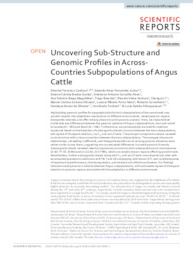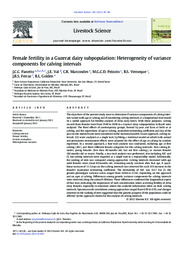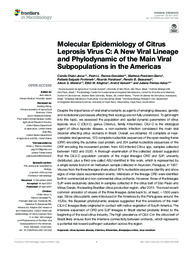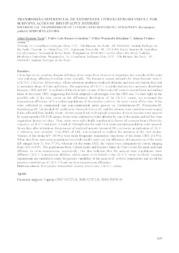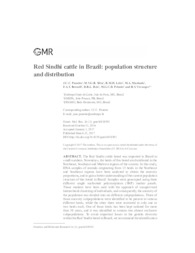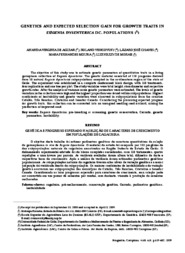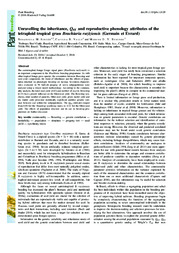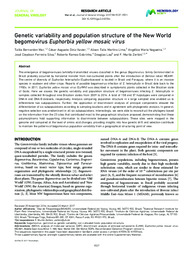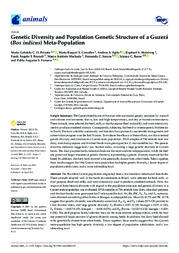Search Publications
Filter by:
| Author(s): CARDOSO, D. F.; FERNANDES JÚNIOR, G. A.; SCALEZ, D. C. B.; ALVEZ, A. A. C.; MAGALHÃES, A. F. B.; BRESOLIN, T.; VENTURA, R. V.; LI, C.; OLIVEIRA, M. C. de S.; PORTO NETO, L. R.; CARVALHEIRO, R.; OLIVEIRA, H. N. de; TONHATI, H.; ALBUQUERQUE, L. G. Highlighting genomic profiles for geographically distinct subpopulations of the same breed may provide insights into adaptation mechanisms to different environments, reveal genomic regions divergently... ... |
| Author(s): PANETTO, J. C. C.; VAL, J. E.; MARCONDES, C. R.; PEIXOTO, M. G. C. D.; VERNEQUE, R. da S.; FERRAZ, J. B. S.; GOLDEN, B. L. The objectives of the present study were to determine if variance components of calving intervals varied with age at calving and if considering calving intervals as a longitudinal trait would be a use... ... |
| Author(s): CHABI-JESUS, C.; RAMOS-GONZÁLEZ, P. L.; POSTCLAM-BARRO, M.; FONTENELE, RA. S.; HARAKAVA, R.; BASSANEZI, R. B.; MOREIRA, A. S.; KITAJIMA, E. W.; VARSANI, A.; ASTUA, J. de F. Despite the importance of viral strains/variants as agents of emerging diseases, genetic and evolutionary processes affecting their ecology are not fully understood. To get insight into this topic, we... ... |
| |
| Author(s): PANETTO, J. C. do C.; SILVA, M. V. G. B.; LEITE, R. M. H.; MACHADO, M. A.; BRUNELI, F. A. T.; REIS, D. R. de L.; PEIXOTO, M. G. C. D.; VERNEQUE, R. da S. The Red Sindhi cattle breed was imported to Brazil in small numbers. Nowadays, the herds of this breed are distributed in the Northeast, Southeast and Midwest regions of the country. In this study, DN... ... |
| Author(s): AGUIAR, A. V. de; VENCOVSKY, R.; CHAVES, L. J.; MOURA, M. F.; MORAIS, L. K. de The objective of this study was to estimate genetic parameters of quantitative traits in a living germplasm collection of Eugenia dysenterica. The genetic material consisted of 110 progenies derived f... ... |
| Author(s): RESENDE, R. M. S.; VALLE, C. B. do; RESENDE, M. D. V. The autotetraploid forage Congo signal grass (Brachiaria ruziziensis) is an important component in the Brachiaria breeding programme. As with other tropical forage grass species, the association betwe... ... |
| Author(s): MAR, T. B.; XAVIER, C. A. D.; LIMA, A. T. M.; NOGUEIRA, A. M.; SILVA, J. C. F.; RAMOS-SOBRINHO, R.; LAU, D.; ZERBINI, F. M. The emergence of begomoviruses (whitefly-transmitted viruses classified in the genus Begomovirus, family Geminiviridae) in Brazil probably occurred by horizontal transfer from non-cultivated plants af... ... |
| Author(s): PEIXOTO, M. G. C. D.; CARVALHO, M. R. S.; EGITO, A. A. do; STEINBERG, R. S.; BRUNELI, F. A. T.; MACHADO, M. A.; SANTOS, F. C.; ROSSE, I. C.; FONSECA, P. A. S. The Brazilian Guzerá population originated from a few founders introduced from India. These animals adapted well to the harsh environments in Brazil, were selected for beef, milk, or dual-purpose (bee... ... |
| Author(s): CABRAL, P. G. C.; MACIEL-ZAMBOLIM, E.; OLIVEIRA, S. A. S. de; CAIXETA, E. T.; ZAMBOLIM, L. Coffee leaf rust is the most limiting disease for coffee cultivation in Brazil. Despite its importance, relatively little is known about the genetic diversity of Hemileia vastatrix, the rust causal ag... ... |
Observation
Some of Embrapa's publications are published as ePub files. To read them, use or download one of the following free software options to your computer or mobile device. Android: Google Play Books; IOS: iBooks; Windows and Linux: Calibre.
Access other publications
Access the Agricultural Research Database (BDPA) to consult Embrapa's full library collection and records.
Visit Embrapa Bookstore to purchase books and other publications sold by Embrapa.

